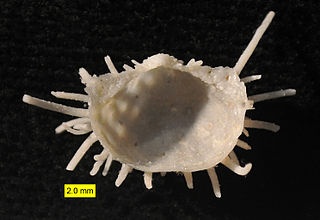
The Ordovician is a geologic period and system, the second of six periods of the Paleozoic Era. The Ordovician spans 41.6 million years from the end of the Cambrian Period 485.4 million years ago (Mya) to the start of the Silurian Period 443.8 Mya.
Kazakhstania, the Kazakh terranes, or the Kazakhstan Block, is a geological region in Central Asia which consists of the area roughly centered on Lake Balkhash, north and east of the Aral Sea, south of the Siberian craton and west of the Altai Mountains. The Junggar basin in Xinjiang, China, is also part of Kazakhstania, though sometimes referred to as the Junggar Block. Because the Kazakh terranes merged during the Late Ordovician as part of the Central Asian Orogenic Belt they are also referred to as the Kazakh Orogen. These terranes are located in what is today Kazakhstan, north-eastern Uzbekistan, northern Kyrgyzstan, south-western China. Today Kazakhstania is surrounded by three large, former continents: to the north-east the Gornostaev Shear Zone separates it from Siberia with which it collided during the Carboniferous; to the north-west is Baltica which lay adjacent to the Kazakh Tourgai terrane but far away from Kazakhstania; to the south and east was Gondwana stretching from the South Pole to the Equator. Not far away from the dispersed Kazakh terranes were South China, North China, and Tarim, but how these continental blocks were positioned relative to Gondwana is not known.

Brachiopods, phylum Brachiopoda, are a group of lophotrochozoan animals that have hard "valves" (shells) on the upper and lower surfaces, unlike the left and right arrangement in bivalve molluscs. Brachiopod valves are hinged at the rear end, while the front can be opened for feeding or closed for protection. Two major groups are recognized, articulate and inarticulate. The word "articulate" is used to describe the tooth-and-groove features of the valve-hinge which is present in the articulate group, and absent from the inarticulate group. This is the leading diagnostic feature (fossilizable), by which the two main groups can be readily distinguished. Articulate brachiopods have toothed hinges and simple opening and closing muscles, while inarticulate brachiopods have untoothed hinges and a more complex system of muscles used to keep the two valves aligned. In a typical brachiopod a stalk-like pedicle projects from an opening in one of the valves near the hinges, known as the pedicle valve, keeping the animal anchored to the seabed but clear of silt that would obstruct the opening.

The origin of the brachiopods is uncertain; they either arose from reduction of a multi-plated tubular organism, or from the folding of a slug-like organism with a protective shell on either end. Since their Cambrian origin, the phylum rose to a Palaeozoic dominance, but dwindled during the Mesozoic.

The Acrotretida are a group (order) of sessile, suspension-feeding brachiopods known from the Cambrian period and surviving until the present day. Their shell has a round outline, and is usually phosphatic in recent specimens.
Aemula is an extinct genus of brachiopods that lived during the Cretaceous period. The pedunculate brachiopod species Aemula inusitata had lived on the bodies of larger animals which served for enough feeding surface, since no large attachment sites were available on the Maastrichtian chalk of the sea floor. It was a very small animal, having a maximum length of 7 mm, and is believed to have been short lived as interpreted from its growth lines.
Mickwitziids are a Cambrian group of shelly fossils with originally phosphatic valves, belonging to the Brachiopod stem group, and exemplified by the genus Mickwitzia – the other genera are Heliomedusa and Setatella. The family Mickwitziidae is conceivably paraphyletic with respect to certain crown-group brachiopods.
Paterinata is an extinct class of Paleozoic Era Linguliform brachiopods.

Productida is an extinct order of brachiopods in the extinct class Strophomenata.

The Capitanian extinction event was an extinction event that occurred around 260 million years ago during a period of decreased species richness and increased extinction rates in the late Middle Permian during the Guadalupian epoch. It is also known as the end-Guadalupian extinction event because of its initial recognition between the Guadalupian and Lopingian series; however, more refined stratigraphic study suggests that extinction peaks in many taxonomic groups occurred within the Guadalupian, in the latter half of the Capitanian age.
Siphonotretida is an extinct order of Brachiopoda, comprising the sole superfamily Siphonotretoidea, itself containing the sole family Siphonotretidae. They are thought to be most closely related to the Lingulellotretidae or dysoristids.
Orthotetida is an order of brachiopods containing the families:
A rhynchonelliform class, characterised by the presence of a colleplax; closest relative (?): Salanygolina.
Protorthida is an extinct order of Rhynchonellate brachiopods containing the taxa:
Orthoidea is a superfamily of brachiopods containing the families:
Plectambonitoidea is a suborder of brachiopods containing the families:
Productidina is a suborder of brachiopods containing the families:
A suborder of brachiopods containing the families:
Ussuniidae is a monogeneric family of Ordovician brachiopods aligned with the Trimerellids, but showing additional similarities to the craniids and considered intermediate in morphology.





